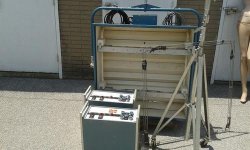x-ray
Veteran
I got into commercial photography as an apprentice in a studio in the early 70's. I look back at the strobe lighting equipment we used and am amazed at how inefficient and big the strobes were at that time. We had some small (all is relative) Photogenic units but they didn't put out much light and were mainly for portraits and small products when we didn't use hot lights. For bigger stuff we had Ascor 800 series units with Clortran / Ascor soft lights. These were aluminum and steel and about 4 feet x4 feet square and were mounted atop heavy duty stands designed to hold 5K hot lights. The total package took two of us to raise it and move it. The unit had 4 1K halogen bulbs for modeling lights and two 3-1/2 foot long quartz flash tubes that were attached to two 680 series 2400ws power packs. Each weighed around 50 pounds each. This was the state of the art at the moment and was the improved version of the Ascor 800 series Sunlights. I never used the sunlight but was aware of them. They were made up of capacitor units weighing somewhere around 65 pounds each and delivered 800ws but required a power supply that weighed as much as 355 pounds. Up to 48 of the capacitors could be connected together and would deliver 40,000ws through a single flash tube. A full complement of capacitors weighed 3,000 pounds. Oh yes, these things were deadly and could kill if not treated with respect.
Here's a little article you might find fascinating.
https://cornicello.com/itfigures/ascoraaaa
Yeh, the good old days!
Here's a little article you might find fascinating.
https://cornicello.com/itfigures/ascoraaaa
Yeh, the good old days!


